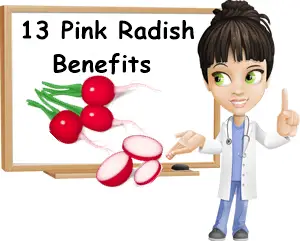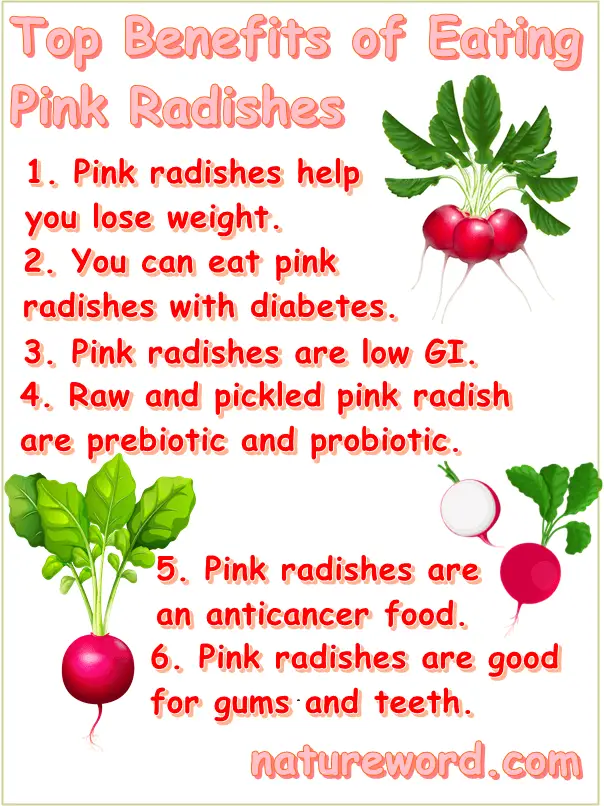Pink radishes are in season right now and one of the best foods to add to your diet. The pink root vegetables have vitamin C and zinc to enhance the immune system, and both nourish and help grow good gut bacteria populations for better digestive health. Pink radishes are also good to eat in diabetes, and help you lose weight. Studies show eating pink radishes lowers blood sugar levels and exerts anticancer effects against several types of cancer.
What are pink radishes good for?
Pink radishes are good for losing weight, relieving constipation, gum and teeth health, high blood pressure, physical tiredness, mental fatigue, anemia, diabetes, and low immunity. Eating pink radishes provides anti-inflammatory and anticancer compounds to the diet in the form of pigmented anthocyanin antioxidants. Pickled pink radishes are good for gut health, helping grow good gut bacteria populations for a healthier gut environment and benefits for general health.

Top 13 benefits of eating pink radishes
Good for losing weight
Pink radishes are good for weight loss diets. How many calories in pink radishes? There are only 16 calories or kilocalories per 100 g of pink radish. This is a very low energetic value that makes pink radishes an ideal food for losing weight. In addition to being low in calories, pink radishes are satiating and filling and help combat hunger.
Good for high blood sugar
If you have high blood sugar, then pink radishes are a good food for you. For one, pink radishes are a low glycemic food with an estimated glycemic index score of 15 to 30 and a glycemic load score of 1 to 2. In other words, pink radishes have very limited effects on blood sugar and do not raise blood sugar levels very much.
More important, studies show radishes in general have hypoglycemic effects, meaning they actively help lower blood sugar levels that are too high. The blood sugar lowering benefits are attributed, at least in part, to ‘insulin-like components (e.g. polyphenolic substances) or glucosidase-inhibiting components’ in the radishes (source).

Good to eat in diabetes
While no food is expressly prohibited in diabetes, some foods are definitely better than others. Pink radishes are good for diabetes for several reasons. For one, they are a low glycemic food with limited effects on blood sugar. Pink radishes are also naturally low in carbs and sugar (3.4 g of carbs of which 1.8 g sugar), and have good amounts of dietary fiber for better blood sugar control.
Another reason why pink radishes are good to eat with diabetes is because they are very low in calories (16 kcal per 100 g) and promote weight loss which is a key aspect of diabetes management. Pink radishes are further good for high cholesterol and high blood pressure, two conditions typically associated with diabetes.
Studies on common pink radishes and diabetes show that biologically active components in the radishes ‘enhance the antioxidant defense mechanism and reduce the accumulation of free radicals’ which affects ‘hormonal-induced glucose hemostasis, promotes glucose uptake and energy metabolism, and reduces glucose absorption in the intestine’ (source 1).
Japanese white Daikon radish and pink radish microgreens, which are essentially radish sprouts, are also good for diabetes. Radish microgreens contain compounds with an ‘insulin-like effect’, improve insulin sensitivity and reduce blood sugar levels (source 2).
Hydrating with tonic, restorative effects
With a water content of over 95 grams per 100 grams and a varied nutritional profile that includes electrolytes such as calcium, magnesium and potassium, and B vitamins, pink radishes are hydrating foods with tonic, restorative properties and an energizing effect.
Good for enriching gut bacteria and boosting gut health
Gut bacteria profile and populations determine the health of the gut environment and have a direct and meaningful impact of general health, affecting everything from weight to energy levels and mood and mental health.
Both raw and pickled pink radishes make an excellent prebiotic and probiotic food. The dietary fiber in the root vegetables and the pickling solution they are immersed in which is acidic represent food for existing gut bacteria populations. Additionally, pickled pink radishes also provide live beneficial microflora to enrich existing gut bacteria populations.
Minor benefits for high blood pressure
Radishes naturally contain potassium and magnesium, two electrolytes with blood pressure lowering effects. Both magnesium and potassium in radishes relive pressure in blood vessels by relaxing and dilating blood vessels which leads to improved blood flow and a drop in blood pressure numbers.
Pink radishes also help combat water retention thanks to electrolytes such as magnesium and potassium which balance body fluids, not to mention they are sodium free.
Good for constipation
If you are experiencing constipation, then upping your intake of fresh fruits and vegetables with skin is advised. Radishes are good for constipation because they are high in water and a source of dietary fiber to both bulk and soften stools for constipation relief.
Support immunity
Eating pink radishes can provide a boost in immunity and support the immune system function. Pink radishes have a good content of vitamin C and small amounts of zinc for better immunity. Immune system cells such as T cells and phagocytes are known to accumulate vitamin C which they use to perform their functions. Moreover, vitamin C and zinc are specifically needed to help create some immune system cells, and have scientifically proven immune system enhancing effects (source).
Vitamin C further has antibacterial, antiviral and anti-inflammatory effects that contribute to the immune system response. But you would have to eat pink radishes raw to get vitamin C. The essential vitamin is extremely sensitive to factors such as cooking heat, but also light and air.
Source of anticancer compounds
Pink radishes are one of the most easily available anticancer foods you can eat. For one, they are one of those foods in season all year round owed to their extensive cultivation. Secondly, they are accessible price wise and a common presence on supermarket shelves and farmers’ markets, as well as easy to grow yourself.
Pink radishes contain organic sulfur compounds called glucosinolates which, after digestion, yield metabolites called isothiocyanates. According to research, both glucosinolates and especially isothiocyanates from pink radishes and radish microgreens demonstrate anticancer activity against a number of cancers such as leukemia, melanoma, prostate, liver, cervical, colon, esophageal and breast cancer (source 1, source 2, source 3, source 4).
According to research, black radishes and Spanish black radishes in particular contain four times more glucosinolates than other crucifers. Moreover, pink radishes contain pigmented anthocyanin antioxidants in their skin with significant anticancer benefits.
Anthocyanins in pink radishes help combat and repair cell damage, prevent mutations in cells and DNA, and enhance programmed cell death in cancer cells. Furthermore, studies show anthocyanins act as a chemoprotective agent by triggering phase II antioxidant enzymes and preventing cancer cell proliferation.
Why are radishes pink?
Radishes become pink because they produce pigmented red and pink-red antioxidants called anthocyanins. For example, pink radishes have pelargonidin, while purple radishes which are darker have cyanidin. However, not all pink foods are pink because of anthocyanins. For instance, gac fruit, pink guava, pink grapefruit, rose hips, pink and red watermelon, sea buckthorn berries, goji berries and tomatoes owe their pink and red pigment to antioxidants called carotenes.
Minor benefits for anemia
Did you know eating pink radishes is good for anemia? Granted, the benefits are minor, but pink radishes have vitamin C to boost iron absorption, and provide small amounts of iron themselves, and vitamin B9 to produce red blood cells.
Good for bleeding gums and teeth health
The good content of vitamin C in pink radishes is a source of benefits for gums and teeth. A sufficient intake of vitamin C helps strengthen capillaries, tiny blood vessels that oxygenate and nourish gums. This is both good for preventing bleeding from the gums, and strengthens the adherence of the gum tissue to teeth. Getting enough vitamin C in your diet can help prevent tooth loss.
But you have to eat the radishes raw to get all of their vitamin C. Can you eat pink radish raw? You can, absolutely. In fact, pink radishes are the healthiest when you eat them raw because, that way, you preserve their nutritional value intact, especially their vitamin C content.
Minor benefits for mental fatigue
Eating pink radishes can be good for mental health and combat mental fatigue and associated side effects such as foggy thinking or brain fog, inability to concentrate, low productivity and low mood. Benefits may stem from the high water content of the vegetable – dehydration is known to impact thinking and other cognitive functions, as well as mental clarity.
B vitamins in pink radishes such as vitamin B9, iron and magnesium also help restore vitality, combat muscle weakness and energize which can have a positive effect on mental health.
Antiaging benefits
You’d never think of pink radishes as an antiaging food, but they are, in fact, one. Pink radishes are a varied source of antiaging compounds: they contain copper, vitamin C, vitamin E, anthocyanins and various other antioxidants which antiaging properties.
Copper helps combat premature hair graying and loss of pigment in the iris of the eyes. Vitamin C stimulates the production of structural tissues such as collagen and elastin for better skin elasticity and fewer wrinkles. Vitamin E helps make up cell membranes and ensures their permeability to absorb nutrients and water for a younger appearance of the skin. Vitamin C, copper, vitamin E and anthocyanins further exert antioxidant and reparative benefits at cell level and combat cell damage.
